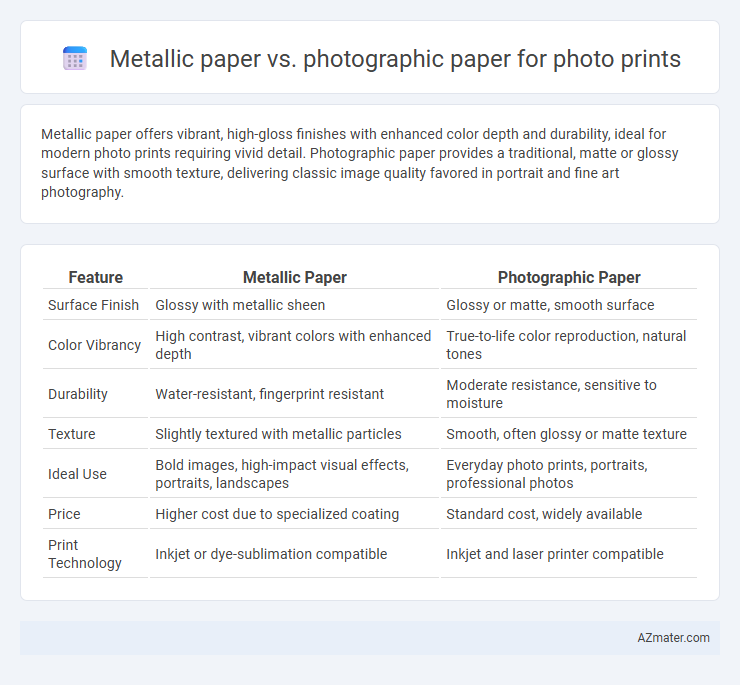Metallic paper offers vibrant, high-gloss finishes with enhanced color depth and durability, ideal for modern photo prints requiring vivid detail. Photographic paper provides a traditional, matte or glossy surface with smooth texture, delivering classic image quality favored in portrait and fine art photography.
Table of Comparison
| Feature | Metallic Paper | Photographic Paper |
|---|---|---|
| Surface Finish | Glossy with metallic sheen | Glossy or matte, smooth surface |
| Color Vibrancy | High contrast, vibrant colors with enhanced depth | True-to-life color reproduction, natural tones |
| Durability | Water-resistant, fingerprint resistant | Moderate resistance, sensitive to moisture |
| Texture | Slightly textured with metallic particles | Smooth, often glossy or matte texture |
| Ideal Use | Bold images, high-impact visual effects, portraits, landscapes | Everyday photo prints, portraits, professional photos |
| Price | Higher cost due to specialized coating | Standard cost, widely available |
| Print Technology | Inkjet or dye-sublimation compatible | Inkjet and laser printer compatible |
Introduction to Photo Printing Papers
Metallic paper offers a vibrant, high-gloss finish with vivid colors and enhanced contrast, making it ideal for dynamic photo prints that require depth and richness. Photographic paper, available in matte, gloss, or semi-gloss finishes, provides exceptional detail and smooth tonal gradients, favored for traditional photo prints and professional portraits. Both types are coated to absorb ink effectively, but metallic paper incorporates a reflective layer that enhances visual impact, while photographic paper emphasizes color accuracy and subtlety.
What is Metallic Paper?
Metallic paper is a type of photo paper known for its glossy finish and vibrant color reproduction, achieved through a mica-coated surface that enhances depth and contrast. Unlike traditional photographic paper, metallic paper provides a unique, shimmering effect that makes images appear more vivid and dynamic, especially in prints featuring bright colors and high contrast. This paper is favored for high-impact photo prints, offering durability and a reflective quality that emphasizes detail and sharpness.
What is Photographic (Traditional) Paper?
Photographic paper, also known as traditional photo paper, is coated with light-sensitive chemicals that capture and develop images through chemical processing. This paper type offers rich color depth, smooth textures, and superior contrast, making it ideal for classic photo prints and archival-quality photographs. Unlike metallic paper, photographic paper provides a matte or glossy finish without the reflective sheen, preserving a more natural and timeless appearance.
Appearance and Finish: Metallic vs Photographic Paper
Metallic paper features a glossy, reflective surface that enhances color vibrancy and depth, creating a striking, almost three-dimensional effect ideal for bold and vivid photo prints. Photographic paper typically offers a smooth, matte or glossy finish with a more traditional look, emphasizing fine detail and natural skin tones without the reflective sheen of metallic prints. The choice between metallic and photographic paper depends on the desired visual impact, with metallic paper providing a high-gloss, luminous finish and photographic paper delivering a classic, soft appearance.
Color Vibrancy and Image Depth
Metallic paper offers exceptional color vibrancy by incorporating a reflective metallic base that enhances contrast and brightness, resulting in richly saturated hues and luminous highlights. Photographic paper, traditionally coated with silver halide crystals, produces natural and smooth tonal gradients with deep blacks but may lack the intensified color pop seen in metallic prints. For image depth, metallic paper creates a striking three-dimensional effect due to its glossy, reflective surface, while photographic paper provides a more classic, matte or glossy finish that focuses on subtle detail and texture.
Durability and Longevity
Metallic paper offers enhanced durability due to its thick, metal-coated base that resists fading, moisture, and scratches, making it ideal for long-lasting photo prints. Photographic paper, especially fiber-based varieties, provides superior color accuracy and detail but is more susceptible to environmental damage like UV exposure and humidity over time. For archival-quality prints, metallic paper outperforms photographic paper in longevity by maintaining vibrant colors and structural integrity under harsh conditions.
Best Use Cases for Metallic Paper
Metallic paper offers vibrant color reproduction and high contrast, making it ideal for prints with vivid landscapes, urban photography, or images requiring a glossy, three-dimensional effect. It enhances metallic tones and adds a reflective quality that boosts visual impact, suitable for professional photo displays, art galleries, and high-end marketing materials. Compared to photographic paper, metallic paper excels in durability and resistance to fading, ensuring long-lasting presentation of premium photographic prints.
Best Use Cases for Photographic Paper
Photographic paper excels in producing high-quality prints with rich color depth and smooth tonal transitions, making it ideal for fine art photography, portraits, and detailed images requiring accurate color reproduction. Its glossy or matte finishes enhance image clarity and contrast, suitable for framing or professional portfolios. Photographic paper is best used when durability and precise color fidelity are essential, especially in controlled lighting environments or gallery displays.
Pricing and Availability Comparison
Metallic paper typically costs more than standard photographic paper due to its specialized coating that enhances color vibrancy and depth, making it a premium choice for high-end photo prints. Photographic paper is widely available in various finishes and price points, often making it more accessible for everyday printing needs and bulk orders. Metallic paper can be less commonly stocked in general retail stores, often requiring purchase from specialty print shops or online suppliers, whereas photographic paper is readily available at most office supply and photo stores.
Choosing the Right Paper for Your Photos
Metallic paper delivers vivid colors and a glossy, reflective finish that enhances contrast and depth, making it ideal for vibrant portrait and landscape photo prints. Photographic paper offers a smooth, matte or glossy surface with fine detail reproduction, perfect for classic photo quality and subtle tones in black-and-white or color images. Selecting the right paper depends on your desired aesthetic and display environment, with metallic paper suited for bold, contemporary visuals and photographic paper preferred for traditional, high-detail prints.

Infographic: Metallic paper vs Photographic paper for Photo print
 azmater.com
azmater.com